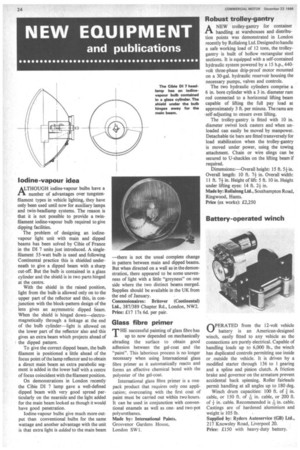Iodine-vapour idea
Page 26

If you've noticed an error in this article please click here to report it so we can fix it.
A.,THOUGH iodine-vapour bulbs have a number of advantages over tungstenfilament types in vehicle lighting, they have only been used until now for auxiliary lamps and twin-headlamp systems. The reason is that it is not possible to provide a twinfilament iodine-vapour bulb required to give dipping facilities.
The problem of designing an iodinevapour light unit with main and dipped beams has been solved by Cibie of France in the DI 7 units just introduced. A singlefilament 55-watt bulb is used and following Continental practice this is shielded underneath to give a dipped beam with a sharp cut-off. But the bulb is contained in a glass cylinder and the shield is in two parts hinged at the centre.
With the shield in the raised position, light from the bulb is allowed only on to the upper part of the reflector and this, in conjunction with the block-pattern design of the lens gives an asymmetric dipped beam. When the shield is hinged down—electromagnetically through a linkage at the end of the bulb cylinder—light is allowed on the lower part of the reflector also and this gives an extra beam which projects ahead of the dipped pattern.
To give the correct dipped beam, the bulb filament is positioned a little ahead of the focus point of the lamp reflector and to obtain a direct main beam an extra parabolic segment is added in the lower half with a centre of focus coincident with the filament position.
On demonstrations in London recently the Cibie DI 7 lamp gave a well-defined dipped beam with very good spread particularly on the nearside and the light added for the main beam looked as though it would have good penetration.
Iodine-vapour bulbs give much more output than conventional bulbs for the same wattage and another advantage with the unit is that extra light is added to the main beam —there is not the usual complete change in pattern between main and dipped beams. But when directed on a wall as in the demonstration, there appeared to be some unevenness of light with a little "greyness" on one side where the two distinct beams merged. Supplies should be available in the UK from the end of January.
Concessionaires: Britover (Continental) Ltd., 387/389 Chapter Rd., London, NW2. Price: £17 17s 6d. per pair.












































































